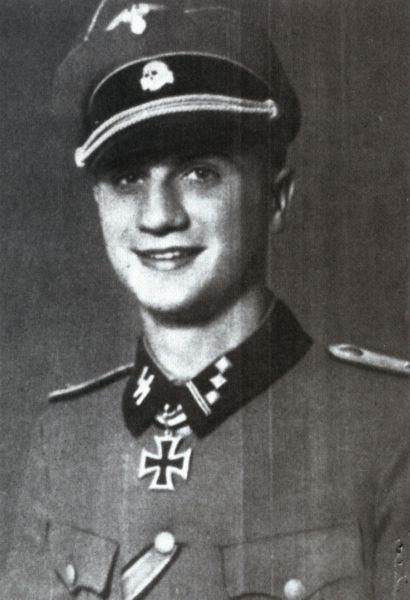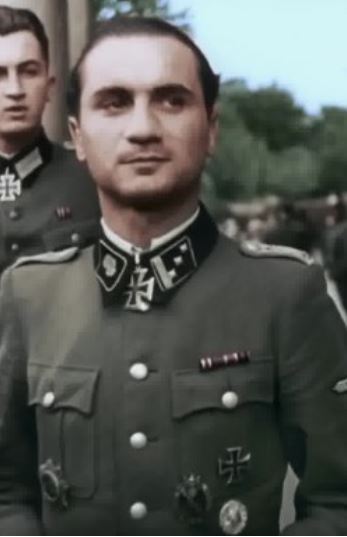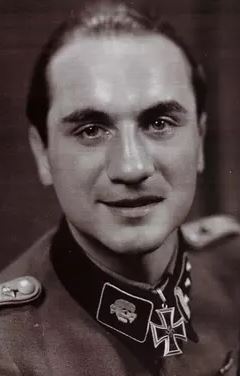Vogt, Fritz (Waffen SS)
- Date of birth:
- March 17th, 1918 (Munich/Bavaria, Germany)
- Date of death:
- April 3rd, 1945 (HVP Fürstenfelde-Graz/Styria, Austria)
- Buried on:
- German War Graves Graz
Plot: 52a. Row: 18. Grave: 180. - Service number:
- SS-Nr.: 270.386 // NSDAP-Nr.:
- Nationality:
- German
Biography
Son of SS-Standartenführer Fritz Vogt (06.11.1890)
Fritz Vogt died of his wounds on 3rd April 1945 aan at Graz. His final position was Kommandeur SS-Panzer-Aufklärungs-Abteilung 5 "Wiking" with the rank of SS-Sturmbannführer.
01.04.1935: Freiwilliger, SS-Standarte "Deutschland", SS-Verfügungstruppe
00.00.1938: SS-Junkerschule Braunschweig
20.04.1939: promoted to SS-Untersturmführer
00.05.1939: SS-Ustuf, Zugführer, 2. / SS-Aufklärungs-Abteilung (mot) - campaing in Poland
00.05.1940: SS-Ustuf, Zugführer, Spähtruppführer, 2. / SS-Aufklärungs-Abteilung (mot) - campaing in France
00.06.1940: promoted to Obersturmführer
00.00.1941: SS-Ostuf, 2. / SS-Aufklärungs-Abteilung 2 - campaign in the Balkans and in Russia
00.09.1941: contracted Typhus
00.10.1941: Lehrer und Ausbilder, SS-Junkerschule Bad Tölz
00.02.1942: SS-Unterführerschule Lauenburg
19.05.1943: promoted to SS-Hauptsturmführer, SS-Panzer-Ausbildungs- und Ersatz-Regiment, Division "Totenkopf"
00.07.1943: SS-Hstuf, Kraftfahrtechnische Lehranstalt der Waffen-SS, Wien
20.10.1943: SS-Hstuf, Kommandeur, I. / SS-Freiwilligen-Panzergrenadier-Regiment 23, Leningrad then Narva
20.04.1944: SS-Hstuf, Kommandeur, I. / SS-Freiwilligen-Panzergrenadier-Regiment 23, Germany
00.11.1944: SS-Hstuf, Kommandeur, I. / SS-Freiwilligen-Panzergrenadier-Regiment 23, 5. SS-Panzer-Division 'Wiking', Hungary
30.01.1945: promoted to SS-Sturmbannführer - fightings near Pettend
00.03.1945: SS-Stubaf, Kommandeur, SS-Panzer-Aufklärungs-Abteilung 5, 5. SS-Panzer-Division 'Wiking'
31.03.1945: severely WIA during a Soviet air raid
03.04.1945: DOW in the Hauptverbandsplatz Fürstenfelde, Austria
Do you have more information about this person? Inform us!
- Period:
- Second World War (1939-1945)
- Rank:
- SS-Untersturmführer (2nd Lieutenant)
- Unit:
- Zugführer, 2. Schwadron, SS-Aufklärungs-Abteilung (mot)
- Awarded on:
- September 23rd, 1939
- Period:
- Second World War (1939-1945)
- Rank:
- SS-Untersturmführer (2nd Lieutenant)
- Awarded on:
- May 10th, 1940
- Period:
- Second World War (1939-1945)
- Rank:
- SS-Untersturmführer (2nd Lieutenant)
- Unit:
- Zugführer, Spähtruppführer, 2. Schwadron, SS-Aufklärungs-Abteilung (mot)
- Awarded on:
- May 27th, 1940
- Period:
- Second World War (1939-1945)
- Rank:
- SS-Obersturmführer (Lieutenant)
- Unit:
- Stoßtruppführer, 2. Schwadron, SS-Aufklärungs-Abteilung, SS-Verfügungs-Division, XXXXI. Armee-Korps
- Awarded on:
- September 4th, 1940
“With this document the SS-Aufkl.Abt. is recommending SS-Obersturmführer Fritz Vogt (born in Munich on the 17.03.1918) for the Knight’s Cross on account of the great successes he has achieved thanks to his extraordinary bravery.
Obersturmführer Vogt has already distinguished himself in the Polish campaign as a patrol leader and Zugführer. For his accomplishments in this time he was awarded the Iron Cross Second Class and recommended for the Iron Cross First Class.
On the 10.05.1940 Obersturmführer Vogt was tasked with taking the Maas-Waal Canal bridge at Neerbosch with a small assault group. This assault group consisted of 2 armoured cars, 3 motorcycle squads and 1 Pak gun, with a Kompanie from M.G. Bataillon 15 following up close behind the assault group as support. However the Dutch were not caught off guard as had been hoped. During the night the bridges were blown, however at the Neerbosch bridge the demolitions only destroyed part of the structure (individual soldiers could still cross).
As the assault group approached the bridge it began taking heavy fire from the bunker line on the western bank (this consisted of concrete embrasures or armoured cupolas every 80-100 metres). Vogt stormed the bridge under covering fire from the Pak and a few MGs; 2 men fell in the process, and Vogt reached the opposite bank with just 4 men initially. Vogt himself was lightly wounded by a shot through the upper arm, yet he continued to fight. By immediately rolling up the bunker line Vogt enabled the remainder of his assault troop as well as the reinforcing M.G. Bataillon 15 to cross. In total over 200 prisoners were taken at this location, and many weapons were captured.
For this deed Vogt was awarded the Iron Cross First Class.
On the 23.05.1940 Vogt was conducting reconnaissance in the direction of Aire with a force consisting of 2 light armoured cars, 1 Pak, 1 radio vehicle and 2 motorcycle squads.
At Mazinhem he identified a French infantry battalion that was retreating towards Lys along a route perpendicular to his own march road. Vogt let his Pak open fire whilst he took his armoured cars and motorcyclists to get around the enemy. By utilizing a hill he was able to get within very close range of the enemy and pour MG fire into their ranks. A short battle ensued that saw the enemy suffer casualties, but eventually 650 men laid down their weapons.
Through this bold deed Vogt succeeded in eliminating the only still combat-capable French battalion in his Division’s sector before it reached the Lys. If this battalion had reached the Lys river it would have made it very difficult for the Division to continue advancing forwards. But, instead, the Division was able to swiftly get across the river and thereby secure a decisive success.
To this it must be added that Vogt only had a reconnaissance mission on this particular day, and he would have faced no consequences or blame if he had instead chosen to desist from attacking such a numerically superior foe.
Vogt subsequently distinguished himself in a commendable fashion once again. On the 07.06.1940 he led a patrol (consisting of 2 armoured cars and 2 motorcycle squads) along the route Mahericourt—Caux—Harbonnières. He managed to intercept 2 enemy artillery pieces at Caux, and at Harbonnières he spotted 250 Frenchmen pulling back in a westerly direction. By ruthlessly striking against them he compelled this much larger enemy force to capitulate.”
202nd Award.
- Period:
- Second World War (1939-1945)
- Awarded on:
- December 1940
- Period:
- Second World War (1939-1945)
- Awarded on:
- 1941
- Period:
- Second World War (1939-1945)
- Rank:
- SS-Obersturmführer (Lieutenant)
- Awarded on:
- June 19th, 1941
- Period:
- Second World War (1939-1945)
- Rank:
- SS-Obersturmführer (Lieutenant)
- Unit:
- Chef, 2. Schwadron, SS-Aufklärungs-Abteilung "Das Reich", 2. SS-Division 'Das Reich'
- Awarded on:
- February 8th, 1942
Award 64/6.
- Period:
- Second World War (1939-1945)
- Awarded on:
- 1942
- Period:
- Second World War (1939-1945)
- Rank:
- SS-Obersturmführer (Lieutenant)
- Awarded on:
- February 9th, 1943
- Period:
- Second World War (1939-1945)
- Rank:
- SS-Hauptsturmführer (Captain)
- Awarded on:
- November 1943
- Period:
- Second World War (1939-1945)
- Period:
- Second World War (1939-1945)
- Period:
- Second World War (1939-1945)
- Rank:
- SS-Sturmbannführer (Major)
- Awarded on:
- February 1945
- Period:
- Second World War (1939-1945)
- Rank:
- SS-Hauptsturmführer (Captain)
- Unit:
- Kommandeur, I. Bataillon, SS-Grenadier-Regiment 23 "Norge", SS-Freiwilligen-Panzer-Grenadier-Division „Nordland“, IV. SS-Panzer-Korps, Heeresgruppe Süd
- Awarded on:
- March 16th, 1945
“1.) As the IV. SS-Panzer-Korps was attacking from the area south of Komorn, through the Vertes mountains and in the direction of Budapest, a Panzergruppe with the subordinated I./SS-Pz.Gren.Rgt. 23 ‘Norge’ was assigned a combat mission for the night of the 04./05.01.1945. It was to advance along the Tarjan road towards the village of Bicske; from there it was to secure the exit from the mountains and block an important enemy supply road (which intersected with another important road north of the village).
Following a bold attack that saw fearsome enemy resistance crushed, the Kampfgruppe reached the ordered area on the same night and formed a hedgehog position (which blocked the supply roads) around a castle.
However the follow-up attacking forces only made slow progress in the face of bitter enemy resistance and terrain difficulties, and they only made contact with this forward Kampfgruppe on the 08.01.1945.
During these 3 days the Kampfgruppe (under the leadership of the distinguished commander of I. Bataillon, SS-Hauptsturmführer Vogt) was totally on its own. In this time the enemy tried to secure this important position with strong combined-arms forces. They attacked by both day and night with the support of tanks and ground attack aircraft, assailing the Kampfgruppe from all sides in the wake of multiple barrages from countless batteries and rocket launchers.
Fierce battles (which usually only ended after close combat) took place. However SS-Hauptsturmführer Vogt defended this important position with unbreakable steadfastness and extraordinary courage. Every night he personally led his reserve Zug in up to 4-5 counterthrusts, repeatedly succeeding in ejecting broken-in enemy forces and thereby preventing the destruction of the encircled Kampfgruppe.
After contact was finally restored SS-Hauptsturmführer Vogt continued to defend this important position for another 4 days against powerful enemy attacks, and by doing so he prevented a penetration into the right flank of those units of the 5. SS-Pz.Div. ‘Wiking’ that were still attacking.
2.) The IV. SS-Panzer-Korps commenced an attack from the area north of Lake Balaton in the direction of the Danube and Budapest, and in the course of this attack the 1. Pz.Div. (located on the left flank) stalled in the face of the enemy’s strongly defended and heavily fortified village of Pettend (located on the northeastern corner of Lake Valence) on the 24.01.1945.
Thus, after it had been removed from its previous position near Lake Valence, the Bataillon was ordered to attack and seize Pettend during the morning hours of the 25.01.1945.
After quickly orienting himself as to the terrain, SS-Hauptsturmführer Vogt made the decision to immediately strike the village in a surprise maneuver from the flank. To this end he did a magnificent job of swiftly bringing up his Bataillon, organizing them for an assault and then swiftly prosecuting the attack towards its intended end. From the ranks of the spearhead Kompanie he entered into the village in the face of a fearsome defense. House after house had to be taken in close combat. Nonetheless, following a ferocious three hour battle, the village was captured.
Such a success (crucial for the continuation of the attack) was first and foremost thanks to the skillful leadership and devotion to duty displayed by the Bataillon commander. 17 tanks were destroyed in the process, and 120 prisoners as well as abundant quantities of weapons and equipment were captured.
3.) Following the seizure of Pettend on the 25.01.1945 the Bataillon received the mission of defending the village, as it was believed that the enemy would use every means at their disposal to retake this important position. This conjecture was already realized on the night of the 26./27.01.1945. Throughout the entire night the enemy pounded the village with a fury that only seemed to increase. Friendly patrols were able to confirm that strong enemy tank and infantry forces were assembling in the area northeast of Pettend.
At 06:30 the enemy attacking along the railroad line with about 20 tanks and 250 men. With this SS-Hauptsturmführer Vogt and his men became locked in a heroic battle for the village. After the Grenadiers had let the tanks overrun them they engaged the hostile infantry. Despite the great enemy superiority as well as the fact that the Bataillon lacked any armour piercing weapons (both of its Pak guns were overrun by enemy tanks at the outset of the engagement), the enemy proved unable to eject the Bataillon from the village. SS-Hauptsturmführer Vogt repeatedly launched lightning counterstrikes with just a few men each time, and these inflicted high losses on the foe. By the afternoon of the same day every single officer of the Bataillon (excluding the commander) had fallen in battle.
Eventually enemy tanks made it to the Bataillon command post (located in the village centre), and due to heavy friendly losses the enemy was able to penetrate our lines all along the edge of the village. With this all contact towards the rear was lost, and so Hauptsturmführer Vogt decided to pull back the remnants of his Bataillon for a last stand defense of the village centre (namely the estate). The enemy surrounded this structure with their tanks and pounded it with unending fire.
To counter this SS-Hauptsturmführer Vogt assembled a small group together before assaulting the enemy tanks with close combat weapons. With a short time 8 enemy tanks were knocked out, 3 by the commander personally via Panzerfausts. After this it was possible to force the enemy out of the majority of the village, and so at 23:00 in the evening the Bataillon commander could report that the village was under friendly control. On this day a total of 53 enemy tanks were destroyed in the sector of the Bataillon, and a previously lost howitzer Batterie belonging to the Wehrmacht was recaptured.
On the following day the enemy renewed their attacks with powerful formations that had just arrived on the battlefield. Thus another bitter fight took place for the keystone position; the estate. 20-25 enemy tanks formed a firm ring around the 3 buildings, which were blasted by their continuous volleys of fire. However the commander and his Bataillon stood firm in the whirlwind of destruction, and the wreckage of the estate was held. During the afternoon hours he exhibited an unprecedented demonstration of readiness and dutifulness by ordering friendly artillery fire to come down on his own position in order to combat those opposing tanks that stood directly before him. After the last rounds of ammunition and last Panzerfausts had been expended, SS-Hauptsturmführer Vogt ordered the remnants of his Bataillon to break out. He was the last to leave the village, and he led his men safely back to friendly lines.
The extraordinary readiness for duty and steadfastness shown here by SS-Hauptsturmführer Vogt produced the following results:
a.) The enemy’s intended breakthrough along the southern bank of Lake Valence by strong tank/infantry forces was prevented.
b.) The removal of two friendly Kampfgruppen for the construction of a new defensive front was enabled.
The ferocity of the fighting that took place here is evident from the fact that the enemy lost 74 tanks in and around Pettend during just 3 days of combat. About 600 enemy dead were also counted on the battlefield.
This battle-proven SS officer and commander appears to be fully worthy of being awarded the Oakleaves to the Knight’s Cross of the Iron Cross on account of his extraordinary leadership qualities, steadfastness and bravery.”
785th Award.
Sources
- Photo 1: Deutsches Wehrkundearchiv
- Photo 2:
- Photo 3:
- Photo: Deutsches Wehrkundearchiv
- - MOONEY, PETER, Waffen-SS Knights and their Battles, Schiffer Pub Ltd, 2008.
- THOMAS, FRANZ & WEGMANN, GüNTER, Die Eichenlaubträger 1940-1945, Biblio-Verlag, 1998.
- fritz vogt.
- fritz vogt.
- fritz vogt.
- Die Ordensträger der Deutschen Wehrmacht (CD), VMD-Verlag GmbH, Osnabrück, 2002
- Kwasny A., Kwasny G., Die Eichenlaubträger 1940-1945 (CD), Deutsches Wehrkundearchiv, Lage-Waddenhausen, 2001
- Fellgiebel W.P., Elite of the Third Reich, The recipients of the Knight's Cross of the Iron Cross 1939-1945: A Reference, Helion & Company Limited, Solihull, 2003, ISBN 1-874622-46-9
- Patzwall K., Scherzer V., Das Deutsche Kreuz 1941-1945, Geschichte und Inhaber Band II, Verlag Klaus D. Patzwall, Norderstedt, 2001, ISBN 3-931533-45-X
- Die Träger des Ritterkreuzes des Eisernen Kreuzes 1939-1945
- Microfilm Publication A3343. US National Archives

























